According to Turks, there’s only one way to prepare borlotti beans. I’m inclined to agree. Since I started cooking this recipe for barbunya pilaki, or Turkish style borlotti beans, I can’t think of a better summer food!
The first annual sighting of borlotti beans at the market is an occasion to be marked. These bright pink speckled beans make for a colourful change from the mostly green offerings of spring. Just the sight of them is enough to make you happy!
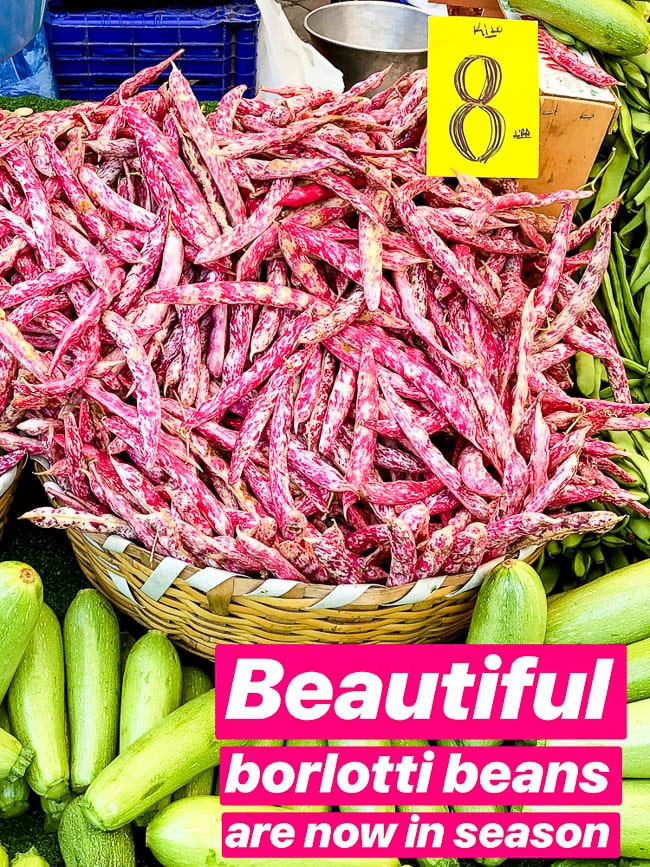
Obviously, I can rarely help myself at the sight. Rare is the occasion where I don’t go home with at least 1 kg in one of my cotton bags, knowing that their season is far too short. By mid summer, they’ll be gone, not to return until next spring.
Perhaps it’s the seasonality of it all. Perhaps it’s the smile those colours brings to my face.
Or perhaps it’s just the comfortingly delicious flavour of the cooked beans.
After trying a few different ways of cooking it, I’ve more or less given up doing them in any other way than the way Turks do them. Pilaki style. It just cannot be beaten. On a list of summer comfort foods, this is surely my number one (closely followed by similarly slow cooked runner beans in olive oil).
What is barbunya?
Let’s delve into what the name of the dish really means.
Barbunya is simply the Turkish word for borlotti beans. You may also know them as cranberry beans, romano beans or, my favourite, rosecoco beans. They’re very popular in Italy and Turkey, but you can find them in many Mediterranean countries (and beyond).
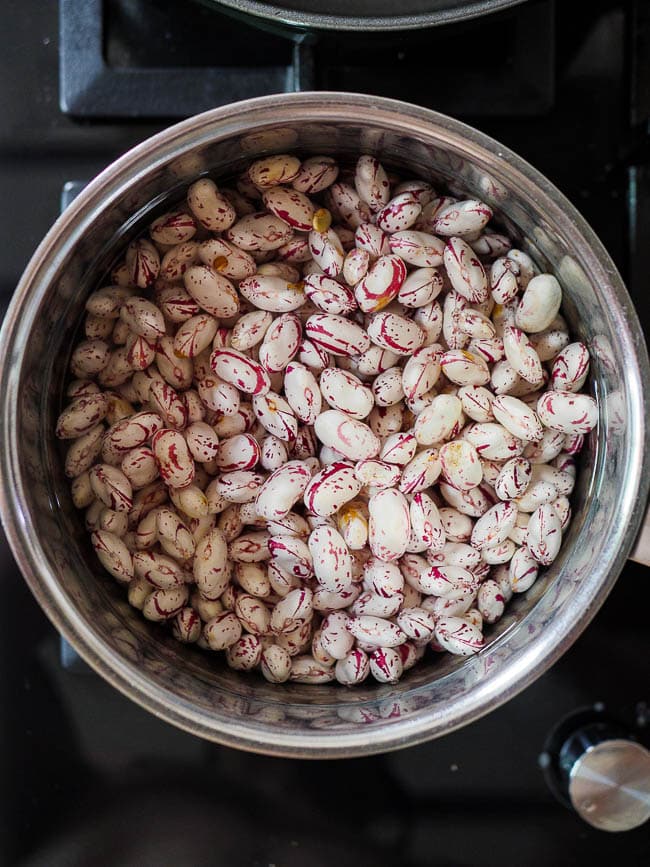
Borlotti beans are a type of white bean, set apart by a spectacular pink or purple speckled colour that runs across the pod as well as the bean. Beautiful! Sadly, the flamboyant colour disappears upon cooking. However, what it loses in colour, it regains in texture and flavour.
These beans are known for being creamy in texture and with a robust, delightful flavour that holds its own better than regular white beans. As such, they’re less dependent on aromatics than, say, cannelloni or haricot beans.
Unlike other types of white beans or legumes such as chickpeas, borlotti beans are usually cooked from fresh during season. They’re also dried and available as such. The texture and flavour are not quite the same, however.
Borlotti beans are therefore highly sought after at the markets during season, which lasts from late spring until mid summer. Indeed, the beans are so iconic, most expats adopt the Turkish word in everyday use, even when speaking in English. I certainly can’t remember the last time I said borlotti beans to a Turk! It’s always barbunya.
The podding requires a little work, but the reward is more than worth it. Podded beans can be frozen and enjoyed year round. You’ll therefore see some people hoarding kilos of the stuff at the market towards the end of the season.
What is pilaki?
Pilaki is a family of dishes where the main ingredient is braised in a simple mixture of onions, garlic, tomato and copious amounts of olive oil. Small cubes of carrot and potato are commonly added as supporting ingredients.
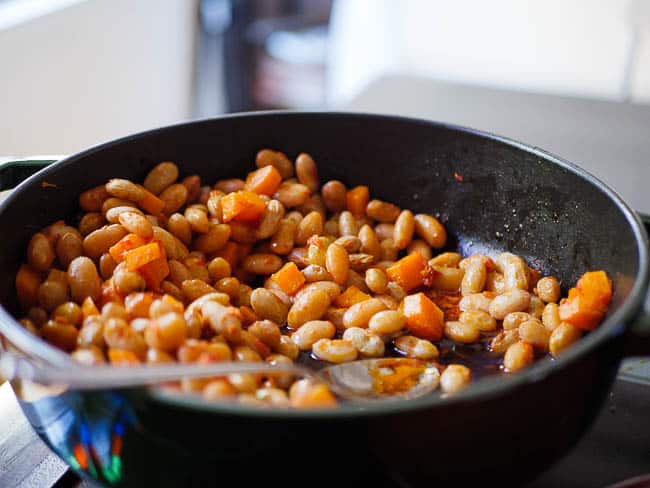
The resulting sauce can be tomato sauce-like, oil-like or anywhere in between. Each cook has his or her own preferences! It’s common to garnish the final dish with a sprinkling of flat-leaf parsley and some lemon juice.
Pilaki style food is popular in Western Turkey in particular, and likely stems from the Greek cuisine of the Eastern Mediterranean. The Greek call these dishes plaki. You also find similar dishes in Bulgaria.
From my experience in Turkey, the version with borlotti beans is the most popular pilaki. However, it can also be made with other legumes such as regular white beans or chickpeas. There are also fish versions, where the fish is braised in the pilaki sauce.
How to make barbunya pilaki
As with most simple, seasonal dishes, barbunya pilaki is easy to make and difficult to perfect.
In other words: Anyone can make a delicious barbunya pilaki, even if you’ve never made it (or even tried it) before. But if you’re in Turkey, you’ll occasionally be lucky enough to be served a barbunya pilaki which makes you wonder how on earth they managed to make it so perfect (clue: it’s probably made by a Turkish grandma).
If you’re not Turkish, however, you’ll do well to pay attention to the tomatoes used. In the West, using tinned tomatoes in common. In Turkey, tinned tomatoes barely exist. Instead, tomato paste, preferably of the homemade, sundried variety, form the basis of most tomato based sauces.
This gives a slightly different flavour than using tinned tomatoes. In this dish, the tomatoes are to be thought of more as a form of seasoning than a key ingredient to a tomato sauce. The stars here are the borlotti beans, not the sauce. Tinned tomatoes will tend to move the whole ordeal into “tomato based bean stew” territory, which is certainly not what we’re looking for here.
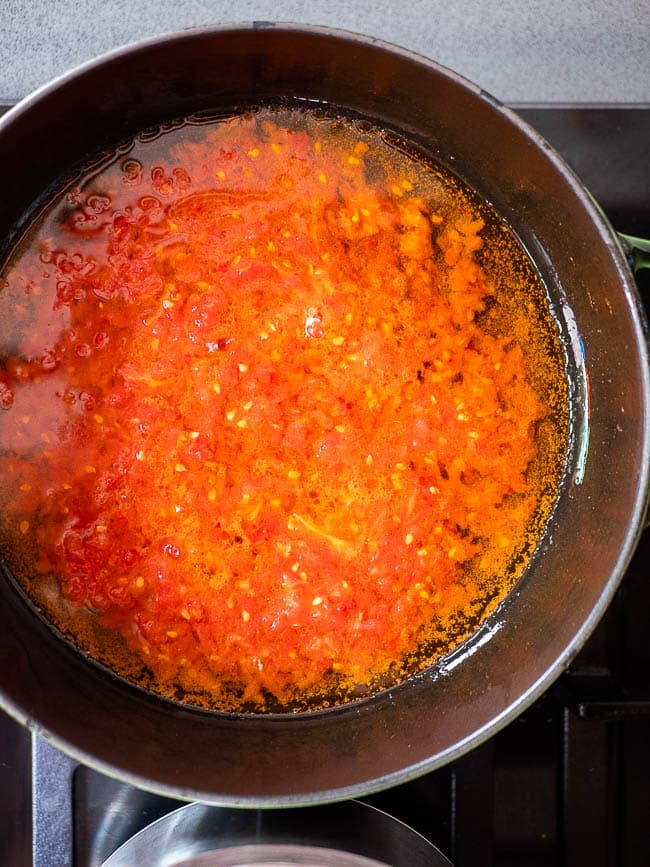
I therefore recommend not to be tempted to replace the tomato paste and fresh tomatoes in the recipe below with a can of tinned tomatoes. Even if your fresh tomatoes aren’t quite up to the glowing, sun ripened tomatoes we get here at the height of summer (in which case just add another pinch of sugar to balance out any bitterness).
Otherwise, the whole thing is pretty straightforward, so I’ll add only one more note (which will clearly need explaining to any Turk reading this).
A note on authenticity
The common way of cooking barbunya pilaki, is to add the shelled, uncooked fresh beans to the sauce, then add water and leave to cook until softened.
I parboil the borlotti beans in salted water before adding. I find this helps with both texture and flavour, as well as shortens the overall cooking time.
Another reason why I do this, is that I prefer my barbunya pilaki not to be too saucy. In fact, I quite like it when the water evaporates almost completely and some of the beans catch on the bottom, becoming slightly caramelised and chewy. This is a personal preference and completely inauthentic.
For a more traditional version, just add another splash of water as directed in the recipe.
Can I use dried or canned borlotti beans to make barbunya pilaki?
Yes, you can! While fresh beans are best, making barbunya pilaki with dried or canned beans will also be very delicious. It also makes the dish more accessible to those of you who live outside of Turkey or Italy, and rarely (if ever) find piles of borlotti beans where you do your food shopping.
If using dried beans, soak and cook as you would any other bean. (I recommend soaking overnight in slightly salted water, then replacing with fresh salted water and boiling over low heat until tender.) Then add the cooked beans to the sauce as per the recipe below. You may want to shorten the cooking time of the pilaki slightly, depending on how well cooked your beans are.
If using canned beans, rinse and drain, then add to the sauce as per the recipe below. Again, you probably need a shorter cooking time, depending on how tender the tinned beans are.
How to serve Turkish style borlotti beans
Barbunya pilaki is served at room temperature or cold. If you like, you can serve it hot as well, but this is not really traditional.
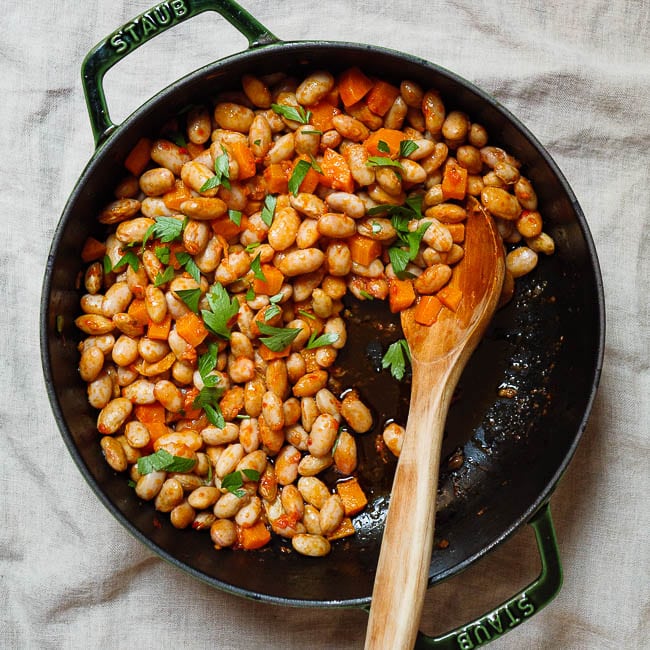
In Turkey, it’ enjoyed as a home meal in its own right, or as one of several mezes ahead of a fish meal.
In the former case, serve it with a generous helping of Turkish style rice, a good dollop of greek yoghurt and a freshly chopped salad. The perfect warm summer’s day dinner, if you ask me! (A glass of rosé isn’t a bad match either, but that’s entirely optional.)
Making a full meze spread at home can be laborious and is usually best left to bigger occasions with lots of guests, but rest assured that barbunya pilaki is delicious as a side dish as well. Perfect alongside grilled fish or chicken, for example.
The recipe serves 3-4, and will keep for several days in the fridge.
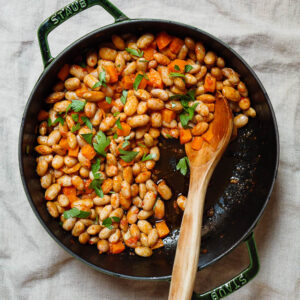
Turkish style borlotti beans (Barbunya pilaki)
Ingredients
- 1 kg fresh borlotti beans, podded (c. 450-500 g/2½ cups podded weight), or see notes for using dried beans
- 100 ml extra virgin olive oil, I use a mild one
- 1 medium onion, finely chopped
- 2 garlic cloves, finely chopped
- 1 Tbsp tomato paste
- 250 g / 2 medium tomato, grated or peeled and chopped
- 175 g / 2 medium carrot, peeled and cut into 1 cm dice
- 125 g / 1 medium potato, peeled and cut into 1 cm dice (optional)
- 1 lemon, thinly sliced, to garnish (optional)
- water
- salt and pepper
How I make it
- Cook the podded borlotti beans in lightly salted water for 5-6 minutes. Drain.
- At the same time, heat a thick bottomed pot or pan over medium/low heat. Add the olive oil and fry the onion until soft, but not coloured, 8-10 minutes, stirring regularly.
- Add the garlic and tomato paste. Fry for another minute or so, stirring constantly. The garlic should not colour.
- Add the tomato. Stir to mix well, then add the carrot, potato, beans, 50 ml water (or more, for a saucier version) and some salt and pepper. Mix well. Bring to the boil, then turn the heat down and leave to simmer, lid on, until the beans are completely soft, 20-30 minutes.
- Take off the heat and leave to cool down to room temperature with the lid still on. Serve topped with a little flat-leaf parsley and some lemon juice, if you like.
Tips & notes
- If using dried beans, soak 200 g dried borlotti beans in plenty of lightly salted water for 8-12 hours, or overnight. Drain, add fresh water and some salt. Bring to a hard boil for 2-3 minutes, then turn the heat down to a gentle simmer and cook until the beans are tender. Then follow the instructions above, starting at step 2, and reducing the cooking time in step 4 if necessary.
- If using canned beans, simply rinse and drain, then follow the instructions above, starting at step 2, and reducing the cooking time in step 4 if necessary.
- You can also use other legumes, such as cannelini beans, butter beans or chickpeas.


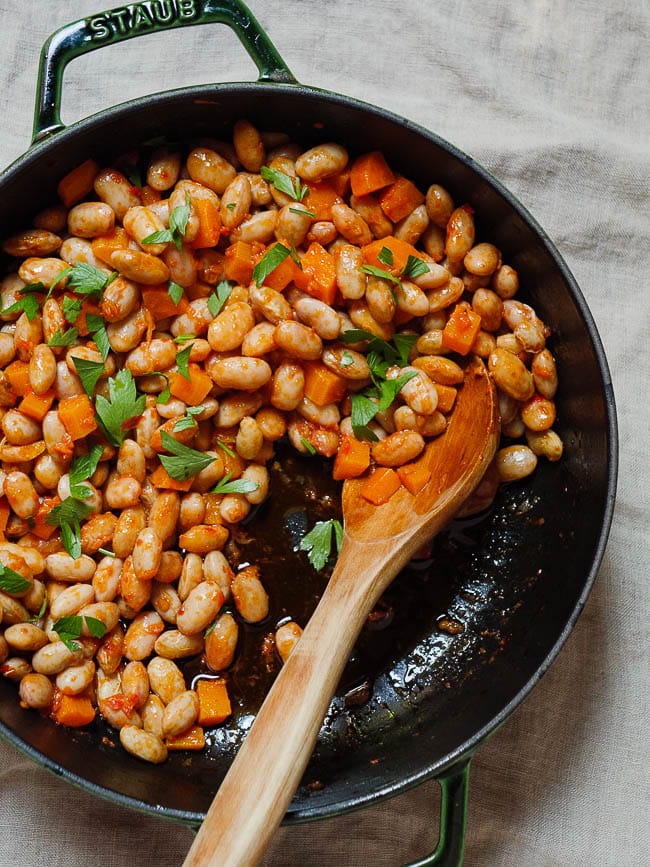
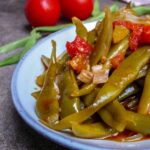
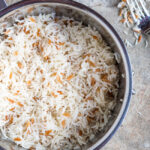


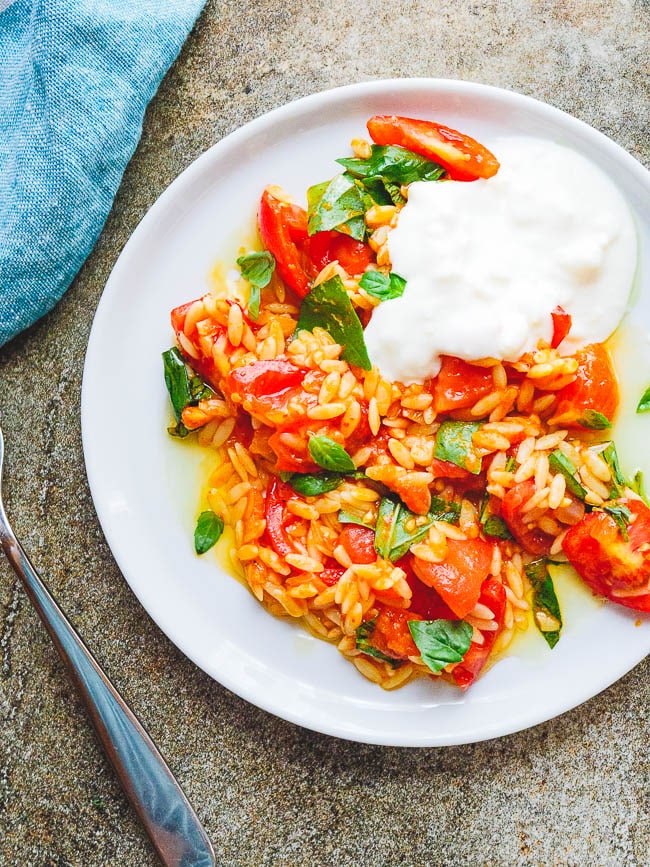
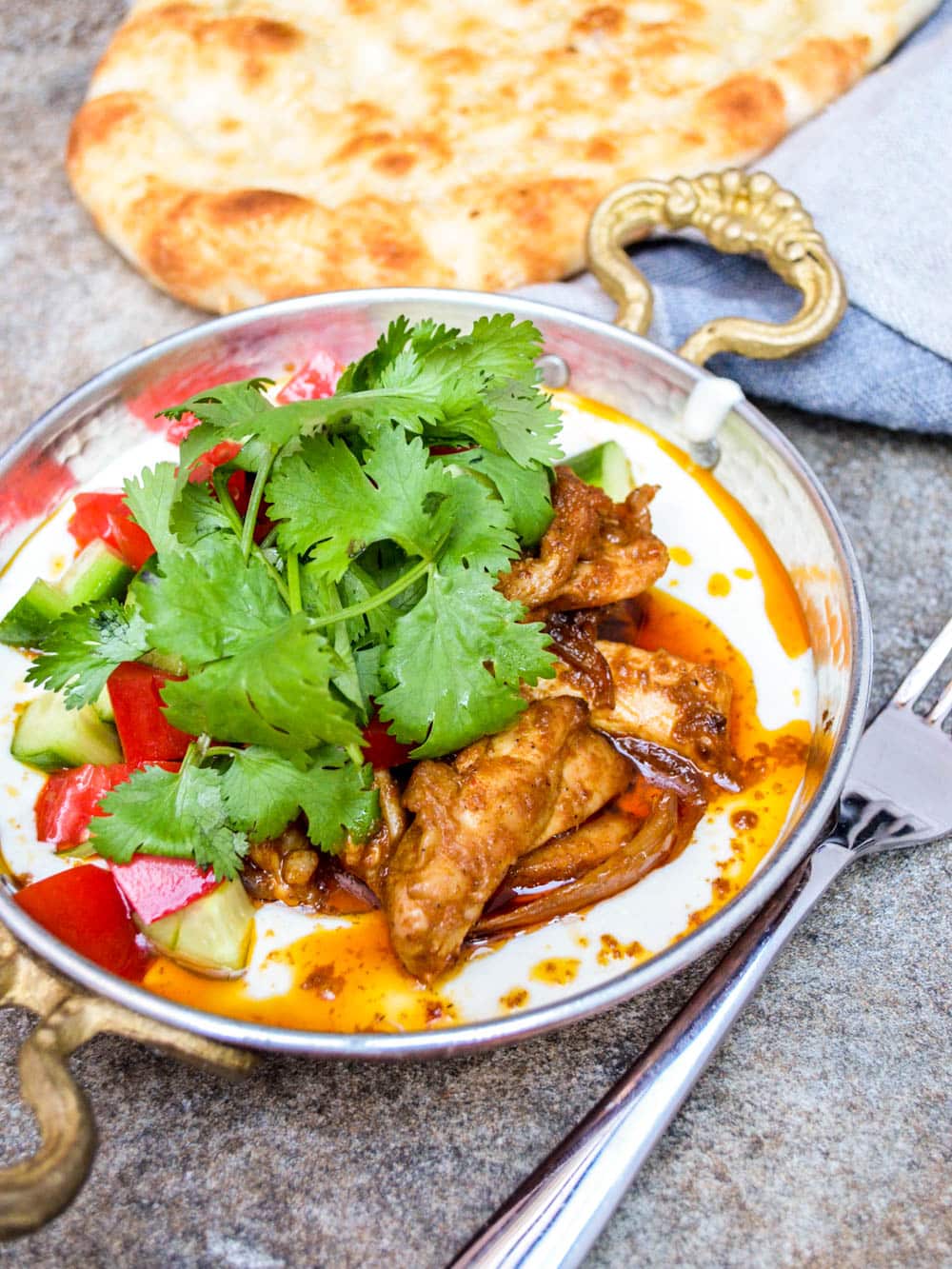
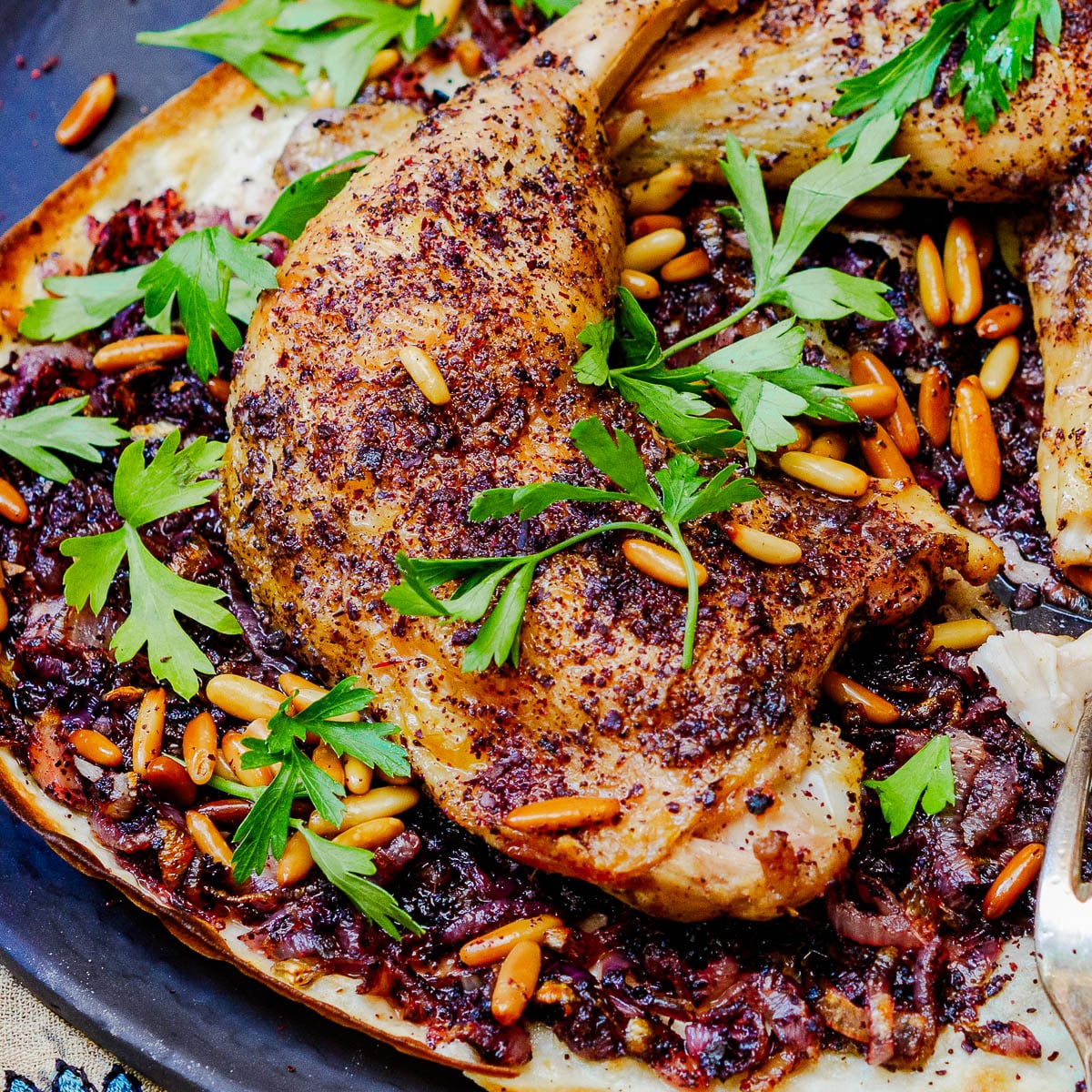
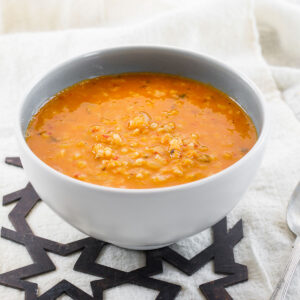
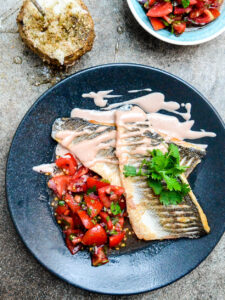
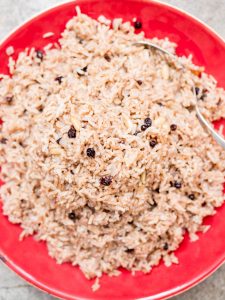




8 responses
I have just cooked these for the second time with my homegrown borlotti beans and each time it has been absolutely amazing. I used too many beans last time because I didn’t read the recipe properly, but nobody complained having to eat them over a few days. 😊
I will continue to use this recipe every year when I get my harvest. Thank you..
Quite lovely. There is a little tone of Hungarian Stuffed Paprika which I guess is a hangover of the Ottoman Empire. Thank you for sharing
Thank you, glad to hear you enjoyed it!
I made this recipe. It was delicious. I added one Tablespoon sugar, because that’s how my Turkish mother made it. Thank you.
Just made this with our home grown borlotti beans. It was fab! Thankyou for the recipe
Barbunya pilaki recipe worked very well and nice to get the history behind it. I had just returned from my allotment with a large bag of freshly picked borlotti beans.
Only drawback was that the food was so tasty there are no leftovers
I must admit to having added about half a cup of diced bacon just after blanching the onions – sorry about adulterating your recipe. But i believe the mark of a good recipe is one that adapts well to change in taste and contents of the fridge and this one does
*oop, typo in my original comment. Barbunya, I meant to type.
Hi there, I just discovered your blog and I’m impressed by how traditional/classic many of the recipes you’ve included are, and the amount of information included with them. I’m from California but grew up eating my Istanbul-born mother’s cooking. I see a lot of what she regularly cooked on your blog. Barnunya was always a favorite of mine, too. I remember helping her shell them :). Thanks for your appreciation of the food & for bringing back these fond memories :).